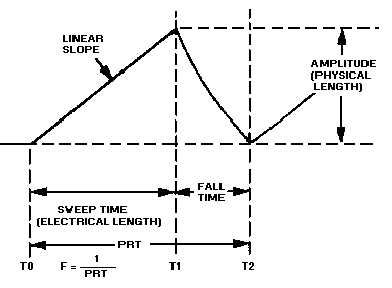3-34
Figure 3-40.—Sawtooth waveform.
The amplitude of the rise of voltage is known as the PHYSICAL LENGTH. It is called physical
length because the greater the peak voltage, the greater physical distance the beam will move. For
example, the amount of voltage needed to move an electron beam 4 inches is twice the amount needed to
move the beam 2 inches across the face of a given crt.
The voltage rise between T0 to T1 is the LINEAR SLOPE of the wave. The linearity of the rise of
voltage is determined by the amount of time the capacitor is allowed to charge. If the charge time is kept
short (10 percent or less of 1TC), the linearity is reasonably good.
As stated in the discussion of time-base generators, the waveform produced from any sawtooth
generator must be linear. A LINEAR SAWTOOTH is one that has an equal change in voltage for an
equal change in time. Referring to the Universal Time Constant Chart in figure 3-39, you can see that the
most desirable part of the charge curve is the first one-tenth (0.1) of the first TC.
Figure 3-41, view (A), is a transistor sawtooth generator. In this figure R1 is a forward-biasing
resistor for Q1, C1 is a coupling capacitor, and Q1 is serving as a switch for the RC network consisting of
R2 and C2. With forward bias applied to Q1, the generator conducts at saturation, and its collector voltage
(the output) is near 0 volts as indicated by the waveform in view (B). The charge felt by C1 is nearly 0. A
negative gate is applied to the base of Q1 to cut off Q1 and allow C2 to charge. The length of time that the
gate is negative determines how long Q1 will remain cut off and, in turn, how long C2 will be allowed to
charge. The length of time that C2 is allowed to charge is referred to as the electrical length of the
sawtooth that is produced.

